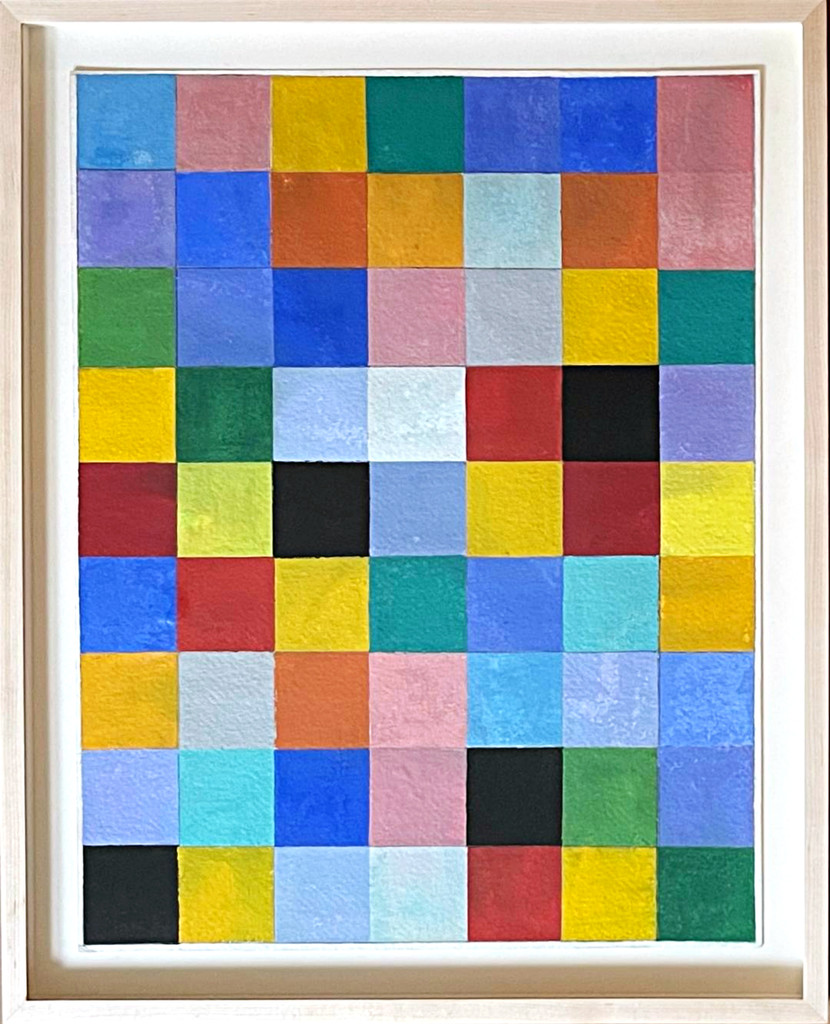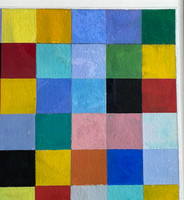
An Educated Collector is Our Best Client
In business for nearly two decades, we are a well established, popular contemporary art boutique specializing in expertly chosen, blue chip prints, multiples, uniques, books, ephemera and merchandise at different price points, with a focus on the secondary market. Please click on the "Contact Us" button at the bottom of this page for questions about any work, pricing and/or to arrange to visit our showroom/gallery - located in between Manhattan's Flatiron and Chelsea Flower Districts.
ALPHA 137 GALLERY
ALPHA 137 GALLERY
Charmion von Wiegand, Intersecting Magic Square, ca. 1963
CONTACT GALLERY FOR PRICE
Description
Charmion von Wiegand
Intersecting Magic Square, ca. 1963
Gouache on paperboard
Signed and titled on the back of the artwork. The signature shown on the frame back is a photo of the actual signature on the artwork itself.
This work is signed and titled on the back of the artwork itself. The signature shown on the back of the frame is a photo of the actual signature, since the pencil signature and title is on the artwork itself.
The Estate of the celebrated artist Charmion Von Wiegand has been represented exclusively by Michael Rosenfeld Gallery since 1998.
From March 3 to August 13, 2023, Charmion Von Wiegand was the subject of an acclaimed retrospective at the Kunstmuseum Basel, and she has received major attention in the price, including a June, 2023 ArtNews feature entitled, "Who Was Charmion von Wiegand and Why Is She Important?".
Artists Biography - courtesy of Michael Rosenfeld Gallery:
Known for her vibrant, geometric paintings that originate a deeply personal language of spiritual enlightenment expressed through a constructivist mode of abstraction, Charmion von Wiegand (1896–1983) was born in Chicago but spent much of her childhood traveling. The daughter of a journalist for Hearst, von Wiegand eventually settled in New York in 1915 to attend Barnard College and Columbia University, where she took classes at the School of Journalism while nurturing a growing interest in art history. In 1925, von Wiegand realized that she wanted to be an artist and set up a studio in Greenwich Village, teaching herself how to paint while pursuing a career as a journalist. In 1929, she secured a position in Moscow as a foreign correspondent for Hearst, the only woman at the desk at the time.
In 1932, von Wiegand returned to New York and married Russian émigré Joseph Freeman, who co-founded and edited the leftist journal New Masses. Von Wiegand began writing art criticism for New Masses as well as for other publications, including New Theatre, ARTnews, and Arts Magazine. When the Abstract American Artists (AAA) held their inaugural exhibition, von Wiegand reviewed it. An early champion of abstract art, von Wiegand became close friends with AAA founder Carl Holty. In 1941, Holty introduced von Wiegand to Piet Mondrian, who would have a profound impact on her art. Fascinated by Mondrian’s artistic philosophy, von Wiegand played a key role in the introduction of his work to American audiences, translating many of the Dutch artist’s writings into English and assisting in the composition of his influential article “Toward the True Vision of Reality” (1941). Through her friendship with Mondrian, von Wiegand re-kindled her interest in Theosophy (a religion established in the late 19th century that combines aspects of Hinduism, Buddhism, occultism, and esotericism) and embarked on an extended study of neoplasticism. In her artwork, she incorporated Mondrian’s iconic grid but rejected the constraints of pure neoplasticism and embraced a wide range of influences including surrealism and German expressionism.
In 1942, von Wiegand became a member of the AAA, exhibiting regularly with the group and eventually serving as its president from 1951 to 1953. In the late 1940s, sculptor and fellow AAA member Ibram Lassaw gave her a translation of The Secret of the Golden Flower: A Chinese Book of Life, which inspired von Wiegand to immerse herself in a study of Buddhist art. She began incorporating Buddhist motifs such as stupas and mandalas into her paintings, and her spiritual practice steadily intensified throughout the 1950s. In 1953, her husband gifted her a copy of the Taoist I Ching Book of Changes, a guide for divining meaning from randomly derived numbers arranged in a hexagram—a form the artist readily incorporated into her painting. Von Wiegand’s study of Theosophy also intensified over these years, bolstered by her increased access to the religion’s primary sources composed by the religion’s founders and their successors at the New York Theosophical Society’s library. Von Wiegand’s search for the sacred and transcendent ultimately led her to Tibetan Buddhism and, in 1967, von Wiegand met Khyongla Rato Rinpoche, a Gelugpa monk who had recently arrived in New York, who would mentor her spiritual study in the tradition of Mahayana Buddhism until her death. Her travels in the 1960s and 1970s took her to Tibet and India, where she had an audience with the Dalai Lama, who was living in exile in Dharamsala. Many works from these decades incorporate symbols and schematics drawn from Theosophical prismatic color charts, Chinese astrology and tantric yoga.
In 1978, she was the subject of a PBS documentary titled The Circle of Charmion von Wiegand, which was scored by Philip Glass. In 1980, von Wiegand was elected to the American Academy of Arts and Letters and in 1982, the Bass Museum of Art in Miami Beach (FL) organized her first retrospective exhibition. She died the following year in New York, bequeathing her estate to Khyongla Rato and the Tibet Center of New York. In 1998, Michael Rosenfeld Gallery became the sole representative of her estate and has presented her work in four solo and multiple group exhibitions. Recent notable exhibitions that have included her work are The Third Mind: American Artists Contemplate Asia (Solomon R. Guggenheim Museum, New York, NY, 2009) and Constructive Spirit: Abstract Art in South and North America (Newark Museum, NJ, 2010). In March 2023, the Kunstmuseum Basel (Switzerland) opened the first comprehensive museum retrospective of von Wiegand’s work in Europe.
Von Wiegand’s work is represented in numerous museum collections including the Addison Gallery of American Art, Phillips Academy (Andover, MA); Albright-Knox Art Gallery (Buffalo, NY); Arithmeum, University of Bonn (Germany); Birmingham Museum of Art (Alabama); Blanton Museum of Art, The University of Texas at Austin; Brooklyn Museum (NY); Carnegie Museum of Art (Pittsburgh, PA); The Cleveland Museum of Art (OH); Indianapolis Museum of Art (IN); Fondazione Marguerite Arp (Locarno, Switzerland); Museum of Fine Arts, Boston (Massachusetts); The Metropolitan Museum of Art (New York, NY); The Museum of Modern Art (New York, NY); Newark Museum of Art (New Jersey); Seattle Art Museum (WA); Smithsonian American Art Museum (Washington, DC); Walker Art Center (Minneapolis, MN); Weatherspoon Art Museum, The University of North Carolina at Greensboro; Wellin Museum of Art at Hamilton College (Clinton, NY); Whitney Museum of American Art (New York, NY); and Yale University Art Gallery (New Haven, CT).
Measurements:
Frame:
21 x 17 x 1.5 inches
Artwork:
18 x 14.25 inches


















